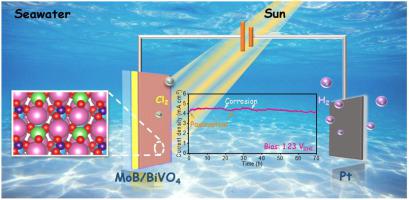Applied Catalysis B: Environment and Energy ( IF 20.2 ) Pub Date : 2021-11-21 , DOI: 10.1016/j.apcatb.2021.120883 Rui-Ting Gao 1 , Xiaotian Guo 1 , Shujie Liu 1 , Xueyuan Zhang 2 , Xianhu Liu 3 , Yiguo Su 1 , Lei Wang 1

|
Solar hydrogen production from seawater, the most natural resource on the earth, is an economically appealing for renewable energy conversion. A photoelectrochemical (PEC) seawater-splitting system is greatly challenging for designing stable photoelectrodes and obtaining high and stable photocurrents, strongly preventing corrosion of semiconductors in seawater. In this context, we for the first time report an ultra-stable seawater splitting PEC cell based on the BiVO4 protected by a MoO3 barrier layer. The combination of MoO3 and Mo/B co-doping on BiVO4 photoanode presents a resembled photocurrent density value of 4.30 mA cm−2 at 1.23 VRHE in simulated seawater and natural seawater under 1 sun AM 1.5G illumination. Equally importantly, the resulting photoanode is quite stable during natural seawater splitting, which shows strong photocorrosion resistance over 70 h of continuous irradiation. Further theoretical calculations provide an insight into the roles of surface dopants for the reduction of substantial surface charge recombination and improving the photocorrosion resistance during long-term operation in the marine environment. This work provides a new avenue for the robust and stable PEC semiconductors design for hydrogen production by seawater photoelectrolysis.
Broader context
Seawater photoelectrolysis is one of the promising alternatives for hydrogen production since sun and seawater represent the two most abundant and available resources reserved on earth. However, the corrosion resistance on photoelectrodes should be paid more attention to long-term operation, where the chloride ions from seawater corrode the electrodes. The highly robust and efficient photoelectrodes are thereby required as one of the critical points on potential application. The BiVO4 photoelectrode is a promising semiconductor for photoelectrochemical (PEC) seawater splitting with a suitable bandgap and favorable conduction band edge position. Unfortunately, this photoelectrode undergoes a poor charge carrier and serious photocorrosion which restricts practical applications for solar energy conversion. In this context, we develop a robust BiVO4 protected with a MoO3 barrier layer, constructing with surface dual-doping engineering, which serves as an outstanding PEC electrode for natural seawater photoelectrolysis. We further demonstrate that the optimized photoelectrode presents a resembled photocurrent density value in simulated seawater and natural seawater under 1 sun AM 1.5G illumination, which shows a strong photocorrosion resistance over 70 h of continuous irradiation, representing one of the targets directly avoiding chloride corrosion on seawater photoelectrolysis.
中文翻译:

用于太阳能制氢的超稳定高性能海水基光电解系统
从海水中生产太阳能氢气是地球上最自然资源的一种,在经济上对可再生能源转换具有吸引力。光电化学(PEC)海水分解系统对于设计稳定的光电极和获得高而稳定的光电流,强烈防止海水中半导体的腐蚀具有很大的挑战性。在这种情况下,我们首次报道了一种基于由 MoO 3阻挡层保护的 BiVO 4的超稳定海水分裂 PEC 电池。在 BiVO 4光阳极上MoO 3和 Mo/B 共掺杂的组合在 1.23 V RHE 下呈现出类似的 4.30 mA cm -2光电流密度值在模拟海水和天然海水中,在 1 太阳 AM 1.5G 光照下。同样重要的是,所得的光阳极在海水自然分解过程中非常稳定,在连续照射 70 小时后表现出很强的抗光腐蚀能力。进一步的理论计算提供了对表面掺杂剂在海洋环境中长期运行期间减少大量表面电荷复合和提高抗光腐蚀性能的作用的深入了解。这项工作为通过海水光电解制氢的稳健而稳定的 PEC 半导体设计提供了新的途径。
更广泛的背景
海水光电解是制氢的有前途的替代方案之一,因为太阳和海水是地球上储备最丰富和可用的两种资源。然而,光电极的耐腐蚀性更应注意长期运行,海水中的氯离子会腐蚀电极。因此需要高度坚固和高效的光电极作为潜在应用的关键点之一。BiVO 4光电极是一种用于光电化学(PEC)海水分裂的有前途的半导体,具有合适的带隙和有利的导带边缘位置。不幸的是,这种光电极的电荷载体较差,光腐蚀严重,限制了太阳能转换的实际应用。在这种情况下,我们开发了一种用 MoO 3保护的强大的 BiVO 4阻隔层,采用表面双掺杂工程构建,是天然海水光电解的优秀PEC电极。我们进一步证明,优化后的光电极在 1 太阳 AM 1.5G 光照下在模拟海水和天然海水中呈现出相似的光电流密度值,在连续照射 70 小时后表现出很强的抗光腐蚀能力,是直接避免氯化物腐蚀的靶标之一。海水光电解。











































 京公网安备 11010802027423号
京公网安备 11010802027423号